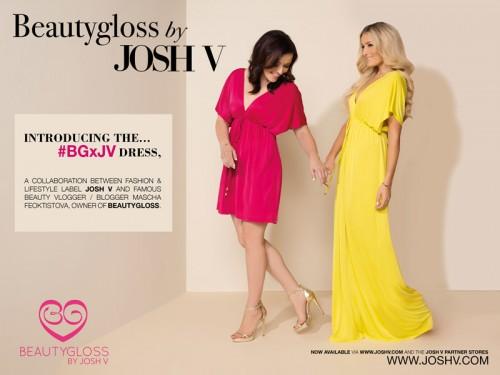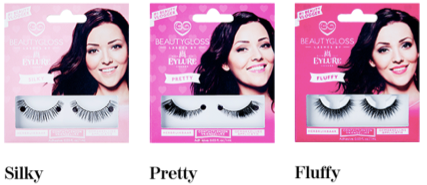
The "rich and famous" of social media: understanding the success of beauty vloggers
Social media has allowed celebrities to directly communicate with their fans. Those social media celebrities dominate millions of subscribers and are emerging as successful celebrities since they can make big money from social media. They are "characterized by their ever present and accessible connectedness to audiences" and ensure recognition, cohesion and intimacy (Hou, 2018). Social media has brought new dynamics and increased autonomy, participation and diversity into the celebrity culture.
With over 600.000 subscribers, Mascha Feoktistova can be seen as a true social media celebrity. In 2007, Masha started to make videos about make-up and beauty products on her YouTube channel called "beautygloss" and in 2016, she was on the 9th place of best-earned Dutch Youtubers (axed, 2016).
In a convergent society, where information and technologies are interconnected, social media has become a useful marketing channel for businesses where celebrities are manufactured with the help of the platform’s business model, commercial intermediaries and the advertising market (Hou, 2018). Taking YouTube beauty vlogging as an example, I will discuss the monetization model and success of social media celebrity Mascha Feoktistova.
Beauty vlogging
Beauty YouTubers, often referred to as beauty vloggers, are people who "create and post videos to YouTube about cosmetics, fashion, hair-styling, and other beauty-related topics". In 2017, beauty-related content generated more than 87 billion views on YouTube (Statista, 2022). As of July 2017, beauty-related content had generated a total of 219 billion views (Statista, 2021) on YouTube, since its existence in 2005.
Through these vloggers' YouTube channels, three major types of content can be distinguished: tutorials, consumer reviews, and consumption exhibitions (Hou, 2018). Applying this to beauty videos, tutorials are 'how-to' videos in which vloggers detail information, trends, tips and tricks about make-up in front of the camera (Hou, 2018). A vloggers' entire makeup routine is, for example, outlined in a tutorial, in addition to the specific steps you need to take to get the same look. Beauty tutorials are very popular on YouTube — a search for "make-up tutorial" yields more than 60 million videos! Consumer review content goes one step further in which beauty vloggers give a summary on beauty, skincare, make-up, or other personal products that they have tried out. In fact, they give feedback and their opinion about those products. Another type of content is consumption exhibition, where vloggers are showing and demonstrating what they have (recently) bought.
Nowadays, it is common for a beauty vlogger to have two or more channels: one ‘main channel’ for beauty-related videos and a second channel that focuses on their daily activities. According to García-Rapp (2016), beauty vlogs can be categorized into two types: commercial-oriented and community-oriented videos. The former is represented by tutorials, consumer reviews and consumption exhibitions, and the latter is represented by vlogs. Following this assumption, it can be stated that commercial-oriented videos are used as a marketing channel for businesses, whereas the community-oriented videos are associated with the ‘slice of life’ idea.
Beautygloss and Vloggloss
Social media celebrity and beauty vlogger Mascha Feoktistova also has, as García-Rapp (2016) claims, two YouTube channels: her professional (main) channel "Beautygloss" and her daily vlog channel "Vloggloss". In 2007, she started Beautygloss, due to the lack of Dutch beauty information and videos. Later on, in 2014, she started her vlog channel "Vloggloss" in which she posts daily videos about her life. Doing so, she takes her camera with her everywhere she goes. She also shows her hair- and make-up routine, shares her conversations with her boyfriend and films her whole house, whereby the 'back region' of her life is now actually in front of the camera.
There are several categories of videos on her Beautygloss channel, which Mascha has grouped into 'make-up tutorials', 'discover products', 'get glam with me', 'cleaning up the beautystash', 'shoplogs', 'food', 'hair tutorials', 'Do It Yourself' (DIY) and 'AMSR relax videos'. What is interesting here, is that Mascha shares her ordinary life on her professional 'main' channel, too. This channel (Beautygloss) consists of, for example, Q&A's in which she gives answer to personal questions about herself. In the Q&A video "How I eat - how much I have lost weight" she explains her lifestyle, how she feels about it and how much weight she has lost. Also, she posted a - somewhat intimate - video about her sex- and personal life in which she gave answers to gossip that existed around her. Questions she answers, include: Is it true that you can not have children? Have you had an orgy on Burning Man? Are you busy with an IVF treatment?
Every Saturday at 3 p.m., we can expect a video on her Beautygloss channel, with a new 'theme' every week, whether it is a make-up tutorial, a product test, a DIY video or a Q&A session. On her Vloggloss channel, she even goes a step further by posting a vlog everyday. Even her husband is sometimes the protagonist in her vlogs in which Mascha, for example, vlogs about Gregor's hair transplantation. Her Vloggloss channel has now over 290.000 subscribers and more than 140 million total views. An interesting question here is whether she earns money from both channels. The answer is yes. She reveals that the main revenue of Vloggloss results from the number of views on YouTube, whereas the revenue of Beautygloss comes from sponsored content. Interestingly, she chooses not to make too much sponsored content on her Vloggloss channel, because she don't want her life to feel like it is fully sponsored.
Monetization model
Social media platforms like YouTube are undergoing a process of institutionalization. More and more homegrown YouTube stars are turning into professional content creators (Kim, 2012). Beauty vloggers stand in the frontier of this professionalization process, thus receiving opportunities for various forms of monetization (Lobato, 2016). According to (Hou, 2018), a vloggers' celebrity status is monetized by YouTube’s platform business model, the Multi-Channel Network (MCN), self-branding practices and marketing needs of other industries, such as the entertainment industry.
Looking at beauty vlogger Mascha Feoktistova, it can be said that she monetizes her videos in several ways. First of all, banners are automatically displayed during Mascha's vlogs where she (probably) receives 55% of the ad revenue from YouTube. Furthermore, sponsored content is displayed in her vlogs. It is, however, unknown how much she monetizes with this form of online advertising. After some criticism about sponsored content in her vlog about Swiss Sense, Mascha responded once: "I do not get paid to film how I choose a bed at Swiss Sense, but I get some discount".
Many vloggers also sign up for a MCN. MCNs can provide technological, financial, legal, talent developing, and marketing solutions. Mascha is under contract with 'Social1nfluencers'. This media company arranges commercial collaborations and helps Mascha to professionalize and grow. A legal team is, for example, bending over her large contracts and offers that she gets from advertisers.
However, Mascha's enrollment in the social media celebrity culture has ensured that her activities have spread beyond YouTube. Given the fact that Beautygloss has become an indispensable platform in the beauty scene, a goodie line was inevitable. On her channels she refers to her webshop where she sells merchandise called "beautygloss goodies". You can buy a drinking bottle, make-up bags, a baseball cap and her own books "happy life" and "happy love life". The offer is not very big, but matches the vlogger and her female target group. Some of the goodies, such as her books, are even for sale on Bol.com. This is an example of self-branding practices.
Another self-branding practice is the event called "Beauty Gloss Party", organized by Mascha. Visitors could buy make-up and other beauty products, meet Mascha, have their make-up and hair done and have a (short) skin analysis. In 2016, she stopped with this event because she wanted to take new challenges. An example of such challenge is her theater performance called Mascha's Story Time (Seijdel, 2016), in which personal anecdotes are told by Mascha. Also, in 2015, Mascha entered into coorperation with fashion designer Josh Veldhuizen. Mascha designed a long maxi and a shorter dress, in four summer colors and prints, known as the BGxJV dresses (see Picture 1).

Picture 1. The BGxJV dresses, called "beauty" and "gloss".
Moreover, in collaboration with Eyelure, Mascha has released her own eyelashes line in 2016 (see Picture 2). In 2017, she again released a new collection. This time Beatygloss nailes. Mascha has been closely involved in the entire development; from the color to even the precise shape of the nails. She, of course, talks about these products in her vlogs and, in addition, gives tutorials about these products.

Picture 2. Mascha's own eyelashes line released in 2016.
Especially for Andrélon, Mascha also developed her own shampoo and conditioner. She has been closely involved in the entire development, from the scents and design to the colors of the bottles and her signature at the bottles. Before announcing the shampoo- and conditioner line, Mascha already revealed in her vlogs that she was busy with a secret project. Smart; she makes her followers curious about this project by posting vlogs where she raised corners of the veil. Eventually, she posted a vlog where she revealed the secret project. This collaboration can be characterized by 'marketing needs of other industries', where both Andélon and Mascha benefit from.
Succesful or not?
In short, Mascha organizes her own events, released two books, sells her own merchandise, designed her own dress in collaboration with Josh V. and developed her own eyelashes, nails and shampoos. In 2011, Mascha received the Viva400 Business Award (Redactie, Monique, 2011). In 2015 and 2016, she won the VEED Award for Best Beauty YouTuber. Looking through all her videos on Beautygloss, I came to the conclusion that she is more than 'just' a beauty vlogger. She shares receipts, answers Q&A's, shares her wedding day and openly admits whether certain gossips about her are true or not.
The success of social media celebrity Mascha can be understood by YouTube platform business model, MCN, self-branding practices and marketing needs of other industries. Her focus is no longer solely online, since she also deepened her celebrity image more and more offline. Previously, she was only seen as a "beauty girl", but nowadays she can be seen as a business woman with dedication that goes beyond just the beauty industry. She has been able to make her work out of her hobby and is now one of the "rich and famous" of both inside and outside social media.
References
axed (2016). ‘Zoveel verdienen de grootste Nederlandse YouTubers in 2016’.
beautygloss. (n.d.). [Video]. YouTube.
García-Rapp, F. (2016). Popularity markers on YouTube’s attention economy: the case of Bubzbeauty. Celebrity Studies, 8(2), 228–245.
Hou, M. (2019). Social media celebrity and the institutionalization of YouTube. Convergence, 25(3), 534–553.
Kim, J. (2012). The institutionalization of YouTube: From user-generated content to professionally generated content. Media, Culture & Society, 34(1), 53–67.
Lobato, R. (2016). The cultural logic of digital intermediaries. Convergence: The International Journal of Research Into New Media Technologies, 22(4), 348–360.
Redactie, Monique. (2011, November 25). Mascha Feoktistova van Beautygloss.nl wint als zakenvrouw in Viva top 400. BeautyJournaal.nl.
Seijdel, M. (2016, August 5). Vlogster komt met eigen theatershow. AD.nl.
Statista. (2021, August 23). YouTube: all-time beauty content category views 2017.
Statista. (2022, November 24). YouTube: annual beauty content views 2009-2018.
Vloggloss. (n.d.). [Video]. YouTube.
Wikipedia contributors. (2023, February 15). Beauty YouTuber. Wikipedia.
Wikipedia contributors. (2023, January 25). VEED Awards. Wikipedia.